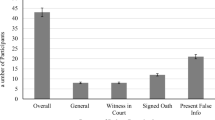M. O’Sullivan and P. Ekman (2004) claim to have discovered 29 wizards of deception detection. The present commentary offers a statistical critique of the evidence for this claim. Analyses reveal that chance can explain results that the authors attribute to wizardry. Thus, by the usual statistical logic of psychological research, O’Sullivan and Ekman's claims about wizardry are gratuitous. Even so, there may be individuals whose wizardry remains to be uncovered. Thus, the commentary outlines forms of evidence that are (and are not) capable of diagnosing lie detection wizardry.
Similar content being viewed by others
Notes
It is under the model based on student judges’ lie detection accuracy that we must make the assumption outlined in the text. Under the model based on the accuracy of all earlier judges, we “predict” 29 wizards by assuming that 2,248 of the 12,000 professionals completed all of the lie detection tests. An alternative statistical analysis would treat as unknown the number of professionals who were invited to take all of the lie detection tests. Then it would use the chance probability of wizard-qualifying performances on the latter two tests to induce the number of professionals who in fact completed the test battery. Applying this alternative treatment in the context of the student judge research-based model, we “predict” 29 wizards if 114 of the 12,000 professionals completed all three tests. Obviously, our two statistical analyses yield different inferences. We ourselves regard the second analysis as more defensible—given that participants were (or were not) invited to complete the test battery based on their self-reports of a test outcome.
REFERENCES
Bond, C. F., Jr., & DePaulo, B. M. (in press). Accuracy of deception judgments. Personality and Social Psychology Review.
Ekman, P., & O’Sullivan, M. (1991). Who can catch a liar? American Psychologist, 46, 913–920.
Ekman, P., O’Sullivan, M., & Frank, M. G. (1999). A few can catch a liar. Psychological Science, 10, 263–266.
Etcoff, N., Ekman, P., Magee, J. J., & Frank, M. G. (2000). Lie detection and language comprehension. Nature, 405, 139.
Frank, M. G., & Ekman, P. (1997). The ability to detect deception generalizes across different types of high-stakes lies. Journal of Personality and Social Psychology, 72, 1429–1439.
Frank, M. G., Paolantonio, N., Feeley, T. H., & Servoss, T. J. (2004). Individual and small group accuracy in judging truthful and deceptive communication. Group Decision and Negotiation, 13, 45–59.
Garrido, E., Masip, J., & Herrero, C. (2002). Police officers’ credibility judgments: Accuracy and estimated ability. International Journal of Psychology, 39, 276–289.
Granhag, P. A., & Stromwall, L. A. (2004). Deception detection in forensic contexts. Cambridge, England: Cambridge University Press.
Howell, D. C. (2002). Statistical methods for psychology (5th ed.). Pacific Grove, CA: Duxbury Press.
Kassin, S. M., & Fong, C. T. (1999). “I’m innocent!”: Effects of training on judgments of truth and deception in the interrogation room. Law and Human Behavior, 23, 499–516.
Meissner, C. A., & Kassin, S. M. (2002). “He's guilty:” Investigator bias and judgments of truth and deception. Law and Human Behavior, 26, 469–480.
Nickerson, C. A. E., & Hammond, K. R. (1993). Comment on Ekman and O’Sullivan. American Psychologist, 48, 989.
Nunnally, J. C. (1978). Psychometric theory (2nd ed.). New York: McGraw Hill.
O’Sullivan, M. (2003). The fundamental attribution error in detecting deception: The boy-who-cried-wolf effect. Personality and Social Psychology Bulletin, 29, 1316–1327.
O’Sullivan, M. (2005). Emotional intelligence and deception detection: Why most people can't ‘read’ others, but a few can. In R. E. Riggio & R. S. Feldman (Eds.), Applications of nonverbal communication (pp. 215–253). Mahwah, NJ: Erlbaum.
O’Sullivan, M., & Ekman, P. (2004). The wizards of deception detection. In P. A. Granhag & L. A. Stromwall (Eds.), Deception detection in forensic contexts (pp. 269–286). Cambridge, UK: Cambridge Press.
O’Sullivan, M., Ekman, P., & Friesen, W. V. (1988). The effect of comparisons on detecting deceit. Journal of Nonverbal Behavior.
Rosenthal, R. (1994). On being one's own case study: Experimenter effects in behavioral research—30 years later. In W. Shadish & S. Fuller (Eds.), The social psychology of science (pp. 214–229). New York: Guilford Press.
Vrij, A. (2001). Detecting lies and deceit: The psychology of lying and the implications for professional practice. New York: Wiley.
Author information
Authors and Affiliations
Corresponding author
About this article
Cite this article
Bond, C.F., Uysal, A. On Lie Detection “Wizards”. Law Hum Behav 31, 109–115 (2007). https://doi.org/10.1007/s10979-006-9016-1
Published:
Issue Date:
DOI: https://doi.org/10.1007/s10979-006-9016-1




